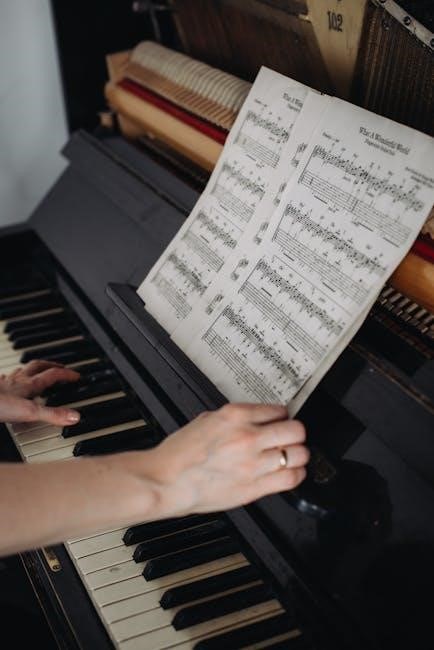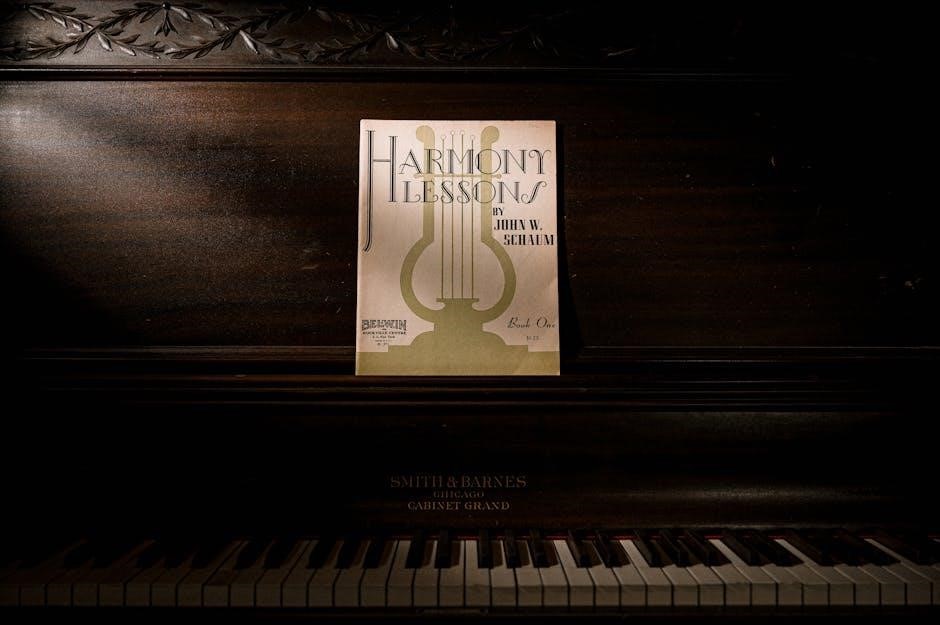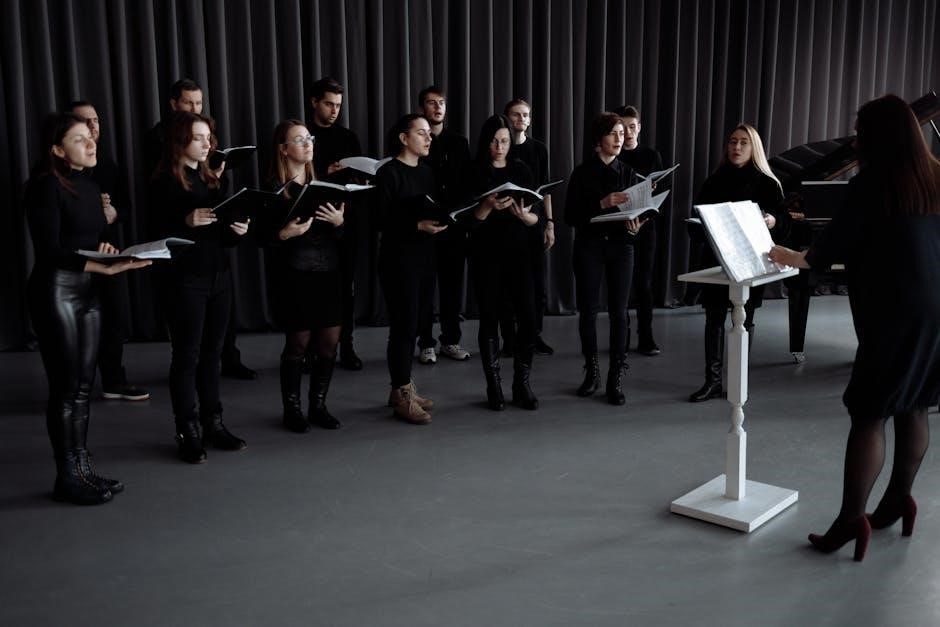ave maria sheet music piano pdf

Ave Maria, composed by Franz Schubert, is a timeless piece of music, widely popular for its serene beauty and emotional depth. Available in PDF and MIDI formats, it offers versatile arrangements, including Schubert’s original and Gounod’s adaptation, making it accessible to pianists of all skill levels. This iconic piece is a favorite for weddings, religious ceremonies, and personal enjoyment, showcasing its universal appeal and enduring legacy in classical music.
History and Background
Ave Maria, composed by Franz Schubert in 1825, is part of his Op. 52, a collection of songs inspired by Walter Scott’s poem The Lady of the Lake. Originally titled Ellens dritter Gesang, it was written in B-flat major and later adapted into the iconic Ave Maria we know today. Schubert’s original version was for voice and piano, but Charles Gounod’s arrangement, which overlays the melody onto Bach’s Prelude in C Major, became widely popular. This piece is celebrated for its serene beauty and emotional depth, making it a timeless classic in classical music.

Sheet Music Versions
Ave Maria is available in various arrangements, including Schubert’s original in B Major, Gounod’s adaptation, and instrumental versions for piano, guitar, and flute. Formats include PDF and MIDI.
3.1 Schubert’s Original
Schubert’s original Ave Maria is a breathtaking vocal piece, later transcribed for solo piano. Set in B Major, it features lyrical melodies and delicate textures, capturing the essence of the composition. This arrangement, graded at a late-intermediate level, is ideal for pianists seeking to explore its emotional depth. Available as a PDF, it retains the original’s serene beauty, making it a popular choice for both performance and personal enjoyment. Its timeless appeal continues to inspire musicians worldwide.
3.2 Gounod’s Arrangement
Gounod’s arrangement of Ave Maria offers a unique interpretation, blending Schubert’s original melody with his own harmonic style. Available in various keys and formats, including PDF and MIDI, it is widely popular for its accessibility and emotional impact. This version is often preferred for its simplicity and versatility, making it suitable for pianists of all levels. Gounod’s adaptation has become a staple in classical music, cherished for its beauty and ease of performance, ensuring its enduring popularity among musicians and audiences alike.
3.3 Instrumental Versions
Ave Maria is available in various instrumental versions, including arrangements for piano, guitar, flute, and other instruments. These versions maintain the piece’s emotional depth while offering flexibility for different performances. Many instrumental arrangements are transposable, allowing musicians to adapt the piece to their preferred key. Whether for solo or ensemble play, these versions provide a rich and expressive way to experience Schubert’s timeless composition. They are widely available in PDF and MIDI formats, catering to both beginners and advanced players.
Downloading Sheet Music
Downloading Ave Maria sheet music in PDF and MIDI is easy, with options for free and paid versions available online, suitable for all skill levels and preferences.
4.1 Free Sources
Free Ave Maria sheet music is widely available online, with platforms like Musicnotes, FreeSheetPianoMusic, and Mutopia offering PDF and MIDI downloads. These sources provide high-quality arrangements suitable for pianists of all levels, from beginners to advanced players. Many versions are transposable, allowing customization to fit individual preferences. Additionally, community-driven sites often feature user-contributed arrangements, ensuring a diverse range of interpretations. These free resources make it easy for musicians to access and enjoy Schubert’s timeless masterpiece without cost.
4.2 Paid Sources
For those seeking high-quality, professional arrangements, paid sources like Musicnotes, Virtual Sheet Music, and Sheet Music Direct offer premium PDF downloads. These platforms provide meticulously transcribed versions of Ave Maria, often featuring multiple arrangements and transpose options. Paid sources ensure clarity, accuracy, and convenience, making them ideal for serious musicians and performers. They also support composers and publishers, contributing to the preservation of classical music. These resources are a valuable investment for those seeking polished and reliable sheet music.

Playing Tips
Ave Maria is a Grade 6 piece, ideal for late-intermediate pianists. Focus on lyrical melodies and delicate textures. Beginners should practice slowly, while intermediates can emphasize dynamics. Advanced players can explore nuanced expressions and tempo variations to enhance the piece’s emotional depth.
5.1 For Beginners
Beginners can start with a slower tempo to master Ave Maria’s lyrical melodies. Practice each hand separately before combining them. Focus on playing legato and maintaining a steady rhythm. Use online tutorials or video lessons for guidance. Start with simplified arrangements to build confidence. Pay attention to dynamics, gradually increasing expression as you progress. Regular practice will help develop finger dexterity and control, making this beautiful piece accessible and enjoyable to perform.
5.2 Intermediate
Intermediate pianists can refine their technique by focusing on dynamics and nuanced phrasing in Ave Maria. Experiment with rubato to enhance emotional expression while maintaining a steady tempo. Pay attention to delicate textures and lyrical melodies, ensuring a smooth legato touch. Practice varying dynamics to highlight the piece’s introspective nature. Intermediate arrangements often include more complex harmonies, allowing for deeper interpretation. Use online tutorials or video lessons to refine challenging sections and explore expressive pedaling techniques to elevate your performance.
5.3 Advanced
Advanced pianists can delve into intricate finger dexterity and nuanced pedaling techniques to enhance Ave Maria’s emotional depth. Focus on precise articulation and dynamic contrasts to convey the piece’s serene yet powerful essence. Explore advanced phrasing and rubato to add personal interpretation while maintaining the composition’s integrity. Utilize the piece’s delicate textures to showcase expressive control, ensuring a captivating performance. Advanced arrangements may include complex harmonies and embellishments, allowing for a sophisticated rendition that highlights both technical skill and artistic interpretation.

Cultural Impact
Ave Maria has become a cultural icon, featured in weddings, funerals, and media, symbolizing serenity and emotional depth. Its universal appeal transcends traditional settings, resonating globally.
6.1 Weddings
Ave Maria is a timeless choice for weddings, its serene beauty and emotional depth creating a memorable atmosphere. Available in PDF and MIDI formats, it offers versatility for ceremonies, from traditional piano arrangements to contemporary instrumental interpretations. The piece’s lyrical melodies and delicate textures resonate deeply, making it a popular selection for brides walking down the aisle or during heartfelt moments. Its universal appeal ensures it complements both classical and modern wedding settings, leaving a lasting impression on guests and celebrating the union with elegance and grace.
6.2 Funerals
Ave Maria is often played at funerals to provide comfort and solace. Its emotional depth and soothing melodies create a tranquil atmosphere, helping mourners reflect and honor their loved ones. Available in PDF and MIDI formats, the piece is easily accessible for funeral services. Its universal appeal makes it a fitting choice for celebrating the life of the deceased, offering dignity and grace during difficult times. The music’s calming essence resonates deeply, providing a sense of peace and closure for those grieving.
6.3 Media Appearances
Ave Maria has been widely featured in films, TV shows, and commercials, enhancing emotional scenes with its serene beauty. Its timeless appeal makes it a popular choice for soundtracks, adding depth and elegance to visual narratives. The piece is also frequently used in video games and promotional content, showcasing its versatility. Additionally, it is often performed in live broadcasts and streaming platforms, further cementing its cultural relevance. Its universal appeal continues to inspire new generations through various media formats.
Original Key and Transpositions
Ave Maria was originally composed by Franz Schubert in the key of B Major (D.839). However, it is widely available in various transpositions, including G Major and E Major, to accommodate different vocal ranges and instrumental preferences. Many sheet music versions offer transposable options, allowing pianists to adjust the key to suit their skill level or performance needs. This flexibility ensures that the piece remains accessible and enjoyable for musicians of all levels, while preserving its timeless beauty and emotional resonance.

Formats Available
Ave Maria sheet music is available in PDF and MIDI formats, ensuring easy access and versatility for pianists. These formats are widely available for download and print.
8.1 PDF
The PDF format of Ave Maria sheet music is widely available, offering clear and convenient access for pianists. It includes Schubert’s original composition and Gounod’s arrangement, with transposable options for various skill levels. PDFs provide high-quality notation, making them ideal for practice, performance, and personal enjoyment. Many websites, such as Musicnotes and Virtual Sheet Music, offer downloadable PDF versions, ensuring accessibility for musicians worldwide. This format remains a popular choice due to its ease of use and versatility across different devices and platforms.
8.2 MIDI
MIDI files of Ave Maria offer a versatile format for musicians, allowing for easy tempo adjustments and key transpositions. These files are ideal for practice, as they can be played back at variable speeds, aiding in learning and mastery. MIDI versions are often available alongside PDF sheet music, providing a digital tool for performance and creativity. They are compatible with most music software, making them a valuable resource for pianists seeking to explore the piece’s nuances in a flexible and interactive way.

Resources and Communities
Online forums and social media groups offer valuable resources for sharing and discovering Ave Maria sheet music. These communities foster collaboration and support among musicians, providing access to exclusive arrangements and performance tips.
9.1 Online Forums
Online forums dedicated to music enthusiasts provide a platform for sharing and discussing Ave Maria sheet music. Communities like Musicnotes, Virtual Sheet Music, and Piano World offer spaces to exchange resources, ask questions, and gain insights from experienced pianists. These forums often feature threads with links to free and paid sheet music, tips for performance, and discussions on various arrangements. They serve as invaluable hubs for musicians seeking to refine their skills or discover new interpretations of Schubert’s beloved composition.
9.2 Social Media Groups
Social media groups dedicated to piano enthusiasts and classical music lovers provide a vibrant space for sharing and discovering Ave Maria sheet music. Platforms like Facebook and Reddit host groups such as “Piano Enthusiasts” or “Sheet Music Lovers,” where members exchange resources, discuss arrangements, and offer tips. These communities often share links to free and paid sheet music, fostering collaboration and learning. They are invaluable for pianists seeking inspiration, feedback, or rare versions of Schubert’s timeless piece.

Performance Considerations
When performing Ave Maria, maintaining a moderate tempo is crucial to preserve its serene and contemplative nature. Dynamics should be handled with care, balancing soft and loud passages to emphasize emotional depth. Pianists are encouraged to play with sensitivity, allowing the melody to flow naturally, ensuring the piece’s timeless beauty shines through in every performance.
10.1 Tempo
The ideal tempo for Ave Maria is moderate, typically marked as Andante quasi adagio, which translates to a slow, contemplative pace. This tempo allows the melody to flow gracefully, emphasizing the piece’s serene and emotional qualities. Pianists should aim for a tempo that supports lyrical phrasing, ensuring the music’s introspective nature is maintained. A tempo of around 100 beats per minute is commonly recommended, though slight variations can accommodate individual interpretive styles while preserving the composition’s timeless beauty and spiritual essence.
10.2 Dynamics
Dynamics play a crucial role in conveying the emotional depth of Ave Maria. The piece often begins with a soft, contemplative tone, marked pianissimo, gradually building to subtle crescendos. Pianists should employ nuanced dynamic contrasts, transitioning seamlessly from delicate piano passages to expressive mezzo-piano sections. Maintaining a sensitive balance between quiet introspection and restrained intensity ensures the music’s serene and spiritual essence shines through. Careful attention to dynamic markings in the sheet music is essential for an authentic and moving performance.

Learning Resources
Explore tutorials and video lessons online to master Ave Maria. Platforms like YouTube and dedicated music websites offer step-by-step guides, while interactive tools enhance practice and understanding.
11.1 Tutorials
Various tutorials and guides are available online to help pianists master Ave Maria. These resources cater to all skill levels, from beginners to advanced players. Video lessons provide visual and auditory instruction, breaking down complex sections into manageable parts. Additionally, many websites offer PDF downloads with annotated scores, highlighting finger placements and dynamics. Platforms like YouTube and specialized music sites feature tutorials by experienced pianists, offering insights into Schubert’s original composition and Gounod’s arrangement; These tools are invaluable for refining technique and interpreting the piece with emotional depth.
11.2 Video Lessons
Video lessons for Ave Maria provide step-by-step guidance, ideal for self-learning. Platforms like YouTube and music education sites offer tutorials by experienced pianists, demonstrating techniques for Schubert’s original and Gounod’s arrangement. These lessons often include close-ups of hand movements, tempo control, and dynamic expression. Many videos cater to different skill levels, from beginners to advanced players, ensuring a comprehensive learning experience. Additionally, some lessons feature accompaniment tracks, helping pianists practice with orchestral or vocal backing, enhancing their performance quality and interpretation of the piece.
Historical Significance
Ave Maria, composed by Franz Schubert in 1825, holds a revered place in classical music history. Originally titled Ellens dritter Gesang (Ellen’s Third Song), it was part of his Op. 52, inspired by Walter Scott’s The Lady of the Lake. Schubert’s masterpiece, written in B-flat major, became synonymous with sacred music despite its literary origins. Its serene melody and emotional depth have made it a timeless classic, widely performed at weddings, funerals, and religious ceremonies, cementing its legacy as one of the most beloved and enduring pieces in classical repertoire.

Modern Adaptations
Ave Maria continues to inspire modern arrangements, blending classical elegance with contemporary styles. Available in various transpositions and instrumental versions, it remains a timeless favorite for musicians worldwide.
13.1 Contemporary Arrangements
Contemporary arrangements of Ave Maria offer fresh interpretations while preserving its timeless essence. Arrangers like thongminh68 and Elaine Kelkel have created unique versions, blending traditional melodies with modern styles. These adaptations often feature simplified or embellished harmonies, making the piece accessible to a broader audience. Available in PDF and MIDI formats, these arrangements allow pianists to explore new creative dimensions while maintaining the song’s emotional depth and spiritual resonance, ensuring its relevance in today’s musical landscape.
13.2 Covers
Ave Maria has inspired countless covers by artists worldwide, each offering a unique interpretation. Pianists like Julie Lind and arrangers such as thongminh68 have created their own versions, blending traditional and modern styles. These covers often feature instrumental solos or vocal accompaniments, showcasing the piece’s versatility. Available in PDF and MIDI formats, these interpretations cater to diverse musical preferences, from classical purists to contemporary enthusiasts, ensuring Ave Maria remains a timeless and universal favorite in various artistic expressions and cultural contexts.
Community and Forums
The global music community actively shares and discusses Ave Maria sheet music, fostering collaboration and learning. Forums like Musicnotes and Virtual Sheet Music host discussions, while social media groups dedicated to classical music connect enthusiasts. These platforms offer a space to exchange tips, share arrangements, and discover new interpretations. Musicians and educators often provide feedback, helping others refine their performances. Such communities not only preserve the piece’s legacy but also inspire new generations to engage with Schubert’s timeless composition, ensuring its continued relevance and appreciation worldwide.

Tutorials and Guides
Tutorials and guides for Ave Maria piano sheet music are widely available, catering to all skill levels. Video lessons on platforms like YouTube and dedicated music websites offer step-by-step instruction, breaking down complex sections. Many resources include practice tips, tempo adjustments, and dynamic control. Websites such as Musicnotes and Virtual Sheet Music provide detailed guides, while pianists like Julie Lind share their interpretations. These tools help musicians master the piece, whether they’re beginners or advanced players, ensuring a polished and emotionally resonant performance of Schubert’s beloved composition.
Ave Maria remains a beloved and timeless piece, with its sheet music widely available in PDF and MIDI formats. Its serene beauty and emotional depth make it a favorite for pianists of all levels. Whether for personal enjoyment, weddings, or religious ceremonies, Schubert’s masterpiece continues to inspire. With numerous arrangements and resources, including tutorials and guides, Ave Maria ensures a lasting legacy, offering musicians a profound connection to its elegance and spiritual resonance, making it a cherished piece for generations to come.





